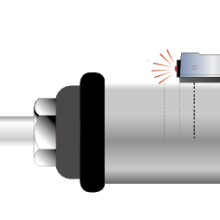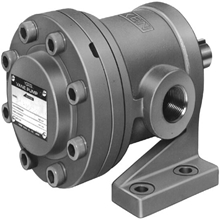What is a valve pump
The vane pump is a device that works on the principle of positive displacement. Consisting of a series of vanes that are mounted to a rotor that provides circulation with the main cavity, the vane pump makes it possible to force liquid through a pipe or duct system at the rate desired by the operator.
In most examples of the vane pump, the vanes slide in and out of the rotor during the operation of the device. This combination of actions creates a seal on the interior of the cavity, and effectively forms a series of small chambers within the larger chamber. Liquid is captured in each of these chambers and is forced through the system by the resulting pressure of the rotation. Essentially, there is atmospheric pressure on the intake side of the pump that helps to suck in the liquid, while the pressure created by the rotating action help to move and discharge the collected liquid from the outtake or discharge side of the pump. The rotor helps to keep the flow of the liquid uniform throughout the process.
A vane pump can be used in a number of different settings. When it comes to use in automobiles, pumps of this type are often employed to move transmission fluid through the system, as well as power steering fluid. In food service settings, a vane pump provides the pumping action that will move carbonators in specific amounts through soda fountain dispensers and coffee machines.
A variation on the vane pumps used in processing liquid substances is the models that deal with the movement of air or some sort of gas. Hydraulic braking systems on diesel powered vehicles make use of this type of pump. Clearing out refrigerant lines in air conditioning equipment is a task that often involves a vane pump. Whether in manufacturing, agriculture, or even around the home, the vane pump can be utilized for many different applications.
What is a gear pump
A gear pump is a mechanical pump that moves liquids by the use of two rotating gears. Liquid flows under pressure from the pump intake to the discharge in the space formed by the gear teeth. The liquid also serves to lubricate the gears. The small clearances between the walls of the pump chamber and gear teeth create a tight seal, thereby preventing liquid from flowing back through the intake. Unlike other types of pumps, gear pumps do not need to be primed and can be ran dry for short periods without damaging the pump. They are typically used to pump water, oil and other liquids.
Gear pumps are capable of producing very high internal pressures and are often used to pump thick liquids such as pitch and crude oil. Pump speeds must be reduced when viscosity increases to allow enough time for the liquid to fill the voids between the gear teeth. A gear pump is capable of pumping very precise amounts of liquid at high pressure and is often used to pump fuel and heating oil, diesel fuel and gasoline. Gear pumps are commonly used in automobile oil pumps and household sump pumps as well.
A gear pump works on the principle of displacement. As the gears rotate inside the gear pump chamber, they create areas of low and high pressure. An area of low pressure, or vacuum, is created between the teeth of the gears when they un-mesh. Liquid flows into this area of lower pressure. As the gear continues to rotate, the liquid becomes trapped in the pocket formed by the gear teeth and the wall of the pump chamber. Finally, an area of higher pressure is created once the gears begin to mesh, forcing the liquid from the gear teeth and into the discharge outlet. Extremely small clearances between the gear teeth and the wall are required in order for the pump to work effectively. Over time, the gear pump will gradually lose efficiency as the clearances increase due to normal wear and tear.
There are two main types of gear pumps, internal and external. The internal gear pump, also known as a gerotor, has two gears. A smaller internal gear fits inside a larger one and both rotate in the same direction. The smaller gear always has one less tooth than the larger one and is mounted off-center in relation to the shaft of the larger gear. This allows the internal gear to rotate freely inside the external gear, while at the same time providing the space needed to pump the liquid from the intake to the discharge of the gear pump. Power is applied to the shaft of the internal gear, which then drives the external gear.
External gear pumps have two identical gears that rotate in opposite directions. Liquid is transported in the space created between the teeth of the gear and the sides of the pump chamber. Power is applied to the shaft of the driving gear, which in turn drives the other gear. Spur gears are usually used in external gear pumps, although helical and herringbone gears are sometimes used when excessive pump noise is a concern.
What is a plunger pump?
A plunger pump is a device used at wastewater treatment plants, car washes, food processing plants, and in the oil and gas industry to regulate the flow of fluids. It consists of two valves mounted in a pumping chamber that controls the action of a plunger into a suction force or discharge force. The design of the machine allows solids to flow freely without clogging the system.
Also called a well service or high viscosity pump, this positive displacement pump uses a mechanism in a cylinder to create action that builds pressure. The pressure forces gas, liquid, or sludge through the pump. Chambers at the inlet valve and outlet valve are both activated by the pressure. The actual plunger can be made from various metals depending on its intended use. When a plunger pump is used at offshore oil rigs, a solid ceramic plunger prevents corrosion from salt water.
Stainless steel is routinely used for plunger pump chambers in the food, pharmaceutical and chemical industries. The chamber can be sterilized after animal waste or chemicals pass through to prevent contamination. These features allow companies to comply with safe processing regulations.
Two kinds of plunger pumps are commonly purchased for home use. A high pressure washer uses the same mechanism as heavy duty pumps. Many homeowners find a portable pressure washer suitable for tough cleaning projects. Sump pumps are often needed when a basement becomes flooded. Both of these types of pumps create pressure through the action of a plunger.
Piston pumps are similar to a plunger pump. The main difference between the two is that a piston moves liquids or solids in place of a plunger. Piston pumps are designed as axial piston pumps or rotary piston pumps, with an internal rotating device that controls flow and pressure. In both types, the capacity is determined by the number of plungers or pistons and the speed of the action.
Trailer-mounted plunger pumps were first produced in 1928. These simple machines could be moved to any areas where high pressure applications were needed. A machine was used by the United States military during WWII to build a remote air base in the South Pacific. The modern, trailer-mounted plunger pump is used for municipal sewer and industrial waste spills, lagoon pumping, and in oil fields.
What is a spiral pump?
A spiral pump , sometimes called a Wirtz pump, is a low lift pump which is composed of a long piece of metal plating, which is wound into a coil and sealed at the top and back extremities so as to resemble a cylinder. The outer cavity serves as the inlet, while the inner (partial) tube serves as the outlet. A coiled plastic tube will suffice for this arrangement. The outlet pipe is fixed to a water wheel, engine or animal which is capable of rotating the pump quickly. Due to this rotation, water is picked up by the outer cavity and pumped upwards in the hose.
Applications
The spiral pump, as many low lift pumps, is commonly used for irrigation purposes and for drainage of lands. Based on the same principle as the Archimedean screw, it consists of a rotating tube or plane (screw) to move a liquid. Unlike the Archimedean screw, it can pump while horizontal. The Archimedean screw must be tilted at an angle. The spiral pump, if fitted with a suitable rotating seal, can deliver water to a greater height than the coil ump, typically 5-10m, above their discharge opening. Its main drawback is that the output is small – an output proportional to the volume of the largest coil being moved each revolution.[1]Despite the emergence of new pumps that operate on other principles, the spiral pump remains an important tool as it can be built and repaired easily at a very low cost. This is possible as all the components can be built from local resources such as sheet metal bent into the desired form with or without machine tools.
Origins
The Zürich pewterer H.A. Wirtz invented the pump in 1736. The first published description and mechanical analysis was written by one JH Ziegler twenty years later, in 1766, with Wirtz’ consent.[2] Wirtz’ original pump was powered by a stream wheelin the Limmat river, to raise water for a dye house.[3][4][5]
- Water Lifting Devices – National Resources Management and Environment: 3.6.4 Coil and Spiral Pumps – Retrieved December 23, 2012 Spiral pump
- Ziegler, J. H. (1766). “Vorläufige Anzeige eines neuen Schöpfrades”. Abhandlungen der Naturforschenden Gesellschaft in Zurich. 3.
- The new encyclopædia; or, Universal dictionary of arts and sciences. 1807. p. 114, ‘Waterworks’, Sect VII.
- The Spiral Pump – A High Lift, Slow Turning Pump – Peter Tailer – First Distributed 1986, Retrieved December 23, 2012
- PDF: Spiral Pumps – How to Make (2008) – Retrieved December 23, 2012














